
What comes to mind when you think of meditation? Probably something along the lines of a person sitting cross-legged on a pillow with their eyes closed, hands placed in an intentional position, and perhaps making the sound of OM. You wouldn’t be wrong, but meditation is a profound practice that goes beyond the common image we see on social media nowadays.
Meditation has roots that go way back. Some scholars believe it’s as old as humanity itself, while others document the practice back to the first set of meditation techniques originating in India over 4,000 years ago, as documented in the oldest Hindu texts. What can be concluded is that it’s an ancient practice that has made its way all the way in to 2020 and doesn’t seem to be going anywhere, anytime soon. Let’s take a look at some reasons why that might be.
What Is Meditation?
 Most commonly today in modern Western society, meditation is the term used to describe the technique of training your mind to be calm, similar to how you go to the gym to train your body to be strong and flexible. Meditation refers to a practice that brings the practitioner into a state of consciousness, connectedness, and profound awareness. Usually attained by sitting still, focusing on breathing, and clearing of erroneous thoughts. It is often described as the journey into stillness, silence, and space. Meditation teaches us to look within ourselves, which ultimately deepens the connection we have to ourselves, and the entirety of life and existence.
Most commonly today in modern Western society, meditation is the term used to describe the technique of training your mind to be calm, similar to how you go to the gym to train your body to be strong and flexible. Meditation refers to a practice that brings the practitioner into a state of consciousness, connectedness, and profound awareness. Usually attained by sitting still, focusing on breathing, and clearing of erroneous thoughts. It is often described as the journey into stillness, silence, and space. Meditation teaches us to look within ourselves, which ultimately deepens the connection we have to ourselves, and the entirety of life and existence.
Slightly varied to modern use and terminology, in traditional Yogic philosophy, meditation is the 7th limb of the 8-Limbed Yogic Path, known as Dhyana. The technique to attain Dhyana, is the 6th limb of the 8-Limbed Yogic Path called Dharana. This yogic path explains that a practitioner must first practice the previous limbs, to then master the technique of focus and concentration (Dharana), to then reach a state of meditation (Dhyana). The practice of concentration brings the practitioner into a state of awareness uninterrupted by thoughts, otherwise known as meditation.
In meditation, the mind is relaxed and still. One known example is to think of a mind that’s engaging in the outside world, processing stimuli, thoughts, and emotions, as similar to a turbulent ocean where it’s difficult to hear or see anything due to the commotion. Compare this to an inwardly focused, silent, and still mind, as similar to a crystal clear, calm sea. One in which you can peacefully see the ecosystems both beneath, above, and between the water and its surroundings. Here we can visualize the difference of a meditative mind versus one that’s actively engaging in thoughts and the external world.
Why Is Meditation Relevant In Our Modern World?
Political tension, changing natural environments, wars, debt, high rent, deadlines, office politics, fires, and deadly viruses. The majority of people have felt stress in some area of modern life, many of whom a significant amount. It’s no secret that modern life while wonderful and exciting, can also be extremely stressful. A lot has changed in the just the past 100 years, and it will continue to. The modern world is often fast-paced with screens full of information always available at our fingertips. Again, while this has its benefits, it can also become emotionally draining, sometimes to the point of mental or physical illness. While meditation isn’t meant to replace professional help, it has proven to be an incredibly powerful aide to remain balanced and clear in a world full of chaos and distractions. One could argue that perhaps it’s more vital today than it was over 3,000 years ago.
 Time spent in silence and stillness, connecting to one’s own inner experience is often pushed further down on the To-Do list in the life of a busy, modern person. As the old Zen saying goes, “You should sit in meditation for 20 minutes a day, unless you’re too busy; then you should sit for an hour.” While not everyone has a full hour to practice meditation, starting small with a realistic goal is beneficial. A three or five-minute meditation can increase a state of calm and peace amidst a world that never sleeps.
Time spent in silence and stillness, connecting to one’s own inner experience is often pushed further down on the To-Do list in the life of a busy, modern person. As the old Zen saying goes, “You should sit in meditation for 20 minutes a day, unless you’re too busy; then you should sit for an hour.” While not everyone has a full hour to practice meditation, starting small with a realistic goal is beneficial. A three or five-minute meditation can increase a state of calm and peace amidst a world that never sleeps.
Try it out for yourself, set a timer every morning, or every night before bed for three to five minutes. Sit with a tall spine on a folded blanket, close your eyes, slow down your breath. Let your thoughts float by, become an observer of yourself. Have patience with yourself as this takes practice. You also might be surprised where you can fit in a longer meditation practice in your day with some strategic maneuvering. Such as only watching one episode of a show instead of three, meal prep to save time cooking dinner, or get your kids involved in the practice with you. Clarity, peace, and awareness are available to all of us with practice, and patience.


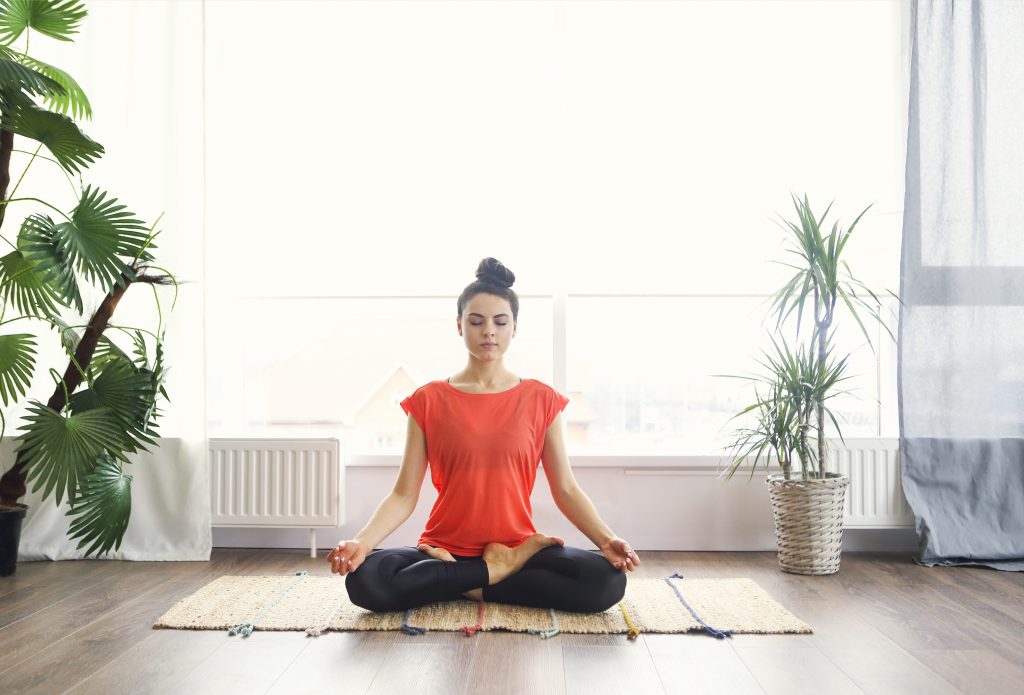
 Yoga has been widely recognized as a way to
Yoga has been widely recognized as a way to 
 This is another foundational pose that lengthens the spine, strengthens the arms and shoulders and stretches the hamstrings. This pose is considered an inversion, helping blood circulate to the brain. This inversion of your blood flow is instantly energizing, and counters symptoms of anxiety and depression.
This is another foundational pose that lengthens the spine, strengthens the arms and shoulders and stretches the hamstrings. This pose is considered an inversion, helping blood circulate to the brain. This inversion of your blood flow is instantly energizing, and counters symptoms of anxiety and depression.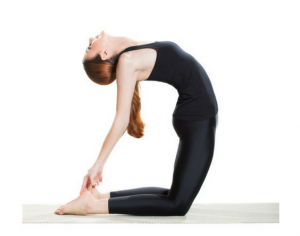 This backbend and chest opener help open the front line of the body. In bridge pose, the back of the neck, where we naturally hold a lot of tension, is stretched. Holding this pose can relieve that tension and ease symptoms of depression.
This backbend and chest opener help open the front line of the body. In bridge pose, the back of the neck, where we naturally hold a lot of tension, is stretched. Holding this pose can relieve that tension and ease symptoms of depression.
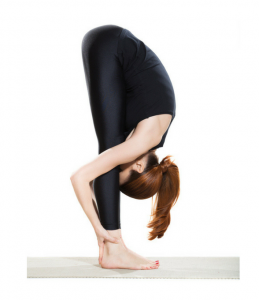 Dropping the head below the heart has a calming effect on the mind and body. In a standing forward fold, the body can quickly relax and get a stretch of the entire back line: from the hamstrings all the way up to the back of the neck. The pose may also help ease headaches and chronic fatigue.
Dropping the head below the heart has a calming effect on the mind and body. In a standing forward fold, the body can quickly relax and get a stretch of the entire back line: from the hamstrings all the way up to the back of the neck. The pose may also help ease headaches and chronic fatigue.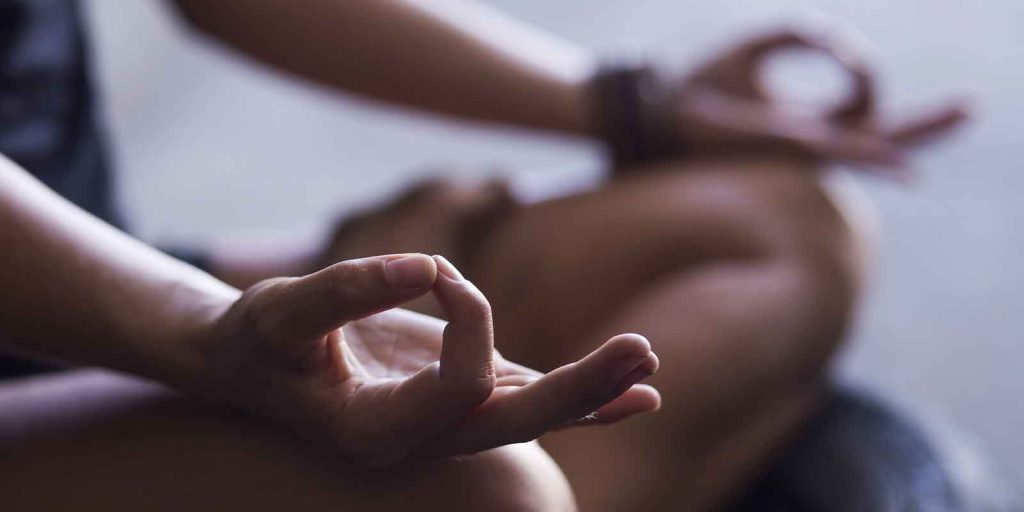

 After you’ve relaxed in Child’s Pose for several minutes, slowly transition to Happy Baby Pose. To do this, walk your fingers toward your torso as you lift your upper body from the mat. Then, untuck your feet from beneath your sit bones and lie flat on your back with your knees bent. Bring your knees into your chest and grip the outsides of your
After you’ve relaxed in Child’s Pose for several minutes, slowly transition to Happy Baby Pose. To do this, walk your fingers toward your torso as you lift your upper body from the mat. Then, untuck your feet from beneath your sit bones and lie flat on your back with your knees bent. Bring your knees into your chest and grip the outsides of your  From the previous asana, release your legs onto the mat with your knees still bent and opened outwards to each side. Make sure to position your feet close to your pelvis Bring the soles of your feet to touch. Remain lying down and allow your arms to rest by your side or on your abdomen. Close your eyes and focus on taking deep breaths for up to 5 minutes in this classic, restorative asana. The benefits include stimulation of the abdominal organs, circulation, and heart as well as a gentle stretch of the thighs and knees.
From the previous asana, release your legs onto the mat with your knees still bent and opened outwards to each side. Make sure to position your feet close to your pelvis Bring the soles of your feet to touch. Remain lying down and allow your arms to rest by your side or on your abdomen. Close your eyes and focus on taking deep breaths for up to 5 minutes in this classic, restorative asana. The benefits include stimulation of the abdominal organs, circulation, and heart as well as a gentle stretch of the thighs and knees. Transitioning from Reclining Bound Angle Pose, position yourself close to a wall and facing the wall, extend your legs up against it. Your back should remain straight and horizontal with your arms resting wherever they are comfortable. In this asana, your sit bones should be either touching the wall or close to it while supporting your legs and your body should be creating a 90 degree angle. Remain in this position for at least 5 minutes as you continue to breathe deeply and steadily. The benefits of this asana include increased circulation, a deep stretch in the lower back and hamstrings, stress relief, and relaxation of the pelvic floor. To exit this pose, slowly bend your knees and shift them to one side as you come to a seated position.
Transitioning from Reclining Bound Angle Pose, position yourself close to a wall and facing the wall, extend your legs up against it. Your back should remain straight and horizontal with your arms resting wherever they are comfortable. In this asana, your sit bones should be either touching the wall or close to it while supporting your legs and your body should be creating a 90 degree angle. Remain in this position for at least 5 minutes as you continue to breathe deeply and steadily. The benefits of this asana include increased circulation, a deep stretch in the lower back and hamstrings, stress relief, and relaxation of the pelvic floor. To exit this pose, slowly bend your knees and shift them to one side as you come to a seated position.
 Begin by sitting on the mat with a straight back and your legs extended in front of you. Feel free to sit on a folded blanket or a bolster for additional support. As you inhale, reach your arms up towards the sky and with a deep exhale, fold your body from your hips as you attempt to reach your knees, feet, or even toes. A key thing to remember is that the goal is not to force your fingertips to your toes; instead, focus on bringing your chest to your thighs, nose to your knees, and forehead to your legs during this stretch. With every exhale, allow tension to be released from your body and surrender even further in this asana. Some benefits of
Begin by sitting on the mat with a straight back and your legs extended in front of you. Feel free to sit on a folded blanket or a bolster for additional support. As you inhale, reach your arms up towards the sky and with a deep exhale, fold your body from your hips as you attempt to reach your knees, feet, or even toes. A key thing to remember is that the goal is not to force your fingertips to your toes; instead, focus on bringing your chest to your thighs, nose to your knees, and forehead to your legs during this stretch. With every exhale, allow tension to be released from your body and surrender even further in this asana. Some benefits of  Let’s end this sequence with a mindful asana to eliminate any meaningless thoughts and ground yourself. Keep your legs extended in front of you on the mat with your arms resting by your sides with your palms facing up. Make sure that your back is straight and there is no arch in your lower back as you lie flat on the mat. Close your eyes and feel your body sink as it becomes heavier with every breath. Corpse Pose is a favorite asana for many people due to its restorative nature. Corpse Pose is a pose of total relaxation which requires remaining in a neutral position, often a challenging task. The purpose of corpse pose is to consciously calm the mind which in turn, calms the nervous system and lowers blood pressure resulting in a state of ultimate serenity. The duration of this asana depends on your preference, however 10-20 minutes are recommended.
Let’s end this sequence with a mindful asana to eliminate any meaningless thoughts and ground yourself. Keep your legs extended in front of you on the mat with your arms resting by your sides with your palms facing up. Make sure that your back is straight and there is no arch in your lower back as you lie flat on the mat. Close your eyes and feel your body sink as it becomes heavier with every breath. Corpse Pose is a favorite asana for many people due to its restorative nature. Corpse Pose is a pose of total relaxation which requires remaining in a neutral position, often a challenging task. The purpose of corpse pose is to consciously calm the mind which in turn, calms the nervous system and lowers blood pressure resulting in a state of ultimate serenity. The duration of this asana depends on your preference, however 10-20 minutes are recommended.
 Savasana integrates asana and
Savasana integrates asana and  Creating a calming environment during the cool down portion of your class will subconsciously prepare your students for savasana. Dim the lights if possible, or turn them off completely. Slowly lower the volume of your regular music until it is mute prior to beginning your breath exercises. Similarly, begin to soften your instructional voice and slow your cadence as you bring your students into their final postures. I find that using the same words to guide my students to the floor, class after class, signals a state of relaxation, with each instruction slower and quieter than the last. Encourage your students to lie down quietly with minimal movement. Instruct them, practice after practice, to relax, to be still, and to let go. Finally, play a rhythmic selection of music especially reserved for savasana, ideally, without words that the mind can grab ahold of.
Creating a calming environment during the cool down portion of your class will subconsciously prepare your students for savasana. Dim the lights if possible, or turn them off completely. Slowly lower the volume of your regular music until it is mute prior to beginning your breath exercises. Similarly, begin to soften your instructional voice and slow your cadence as you bring your students into their final postures. I find that using the same words to guide my students to the floor, class after class, signals a state of relaxation, with each instruction slower and quieter than the last. Encourage your students to lie down quietly with minimal movement. Instruct them, practice after practice, to relax, to be still, and to let go. Finally, play a rhythmic selection of music especially reserved for savasana, ideally, without words that the mind can grab ahold of. This calls to attention the
This calls to attention the  Tight hips or preexisting yoga injuries can cause knee pain or discomfort around the knee. The common instructions to maintain proper alignment in poses that involve bending the knees are to track the kneecaps over the second middle toe, but that is something that can vary from person to person, depending on their circumstances and goals of their practice.
Tight hips or preexisting yoga injuries can cause knee pain or discomfort around the knee. The common instructions to maintain proper alignment in poses that involve bending the knees are to track the kneecaps over the second middle toe, but that is something that can vary from person to person, depending on their circumstances and goals of their practice.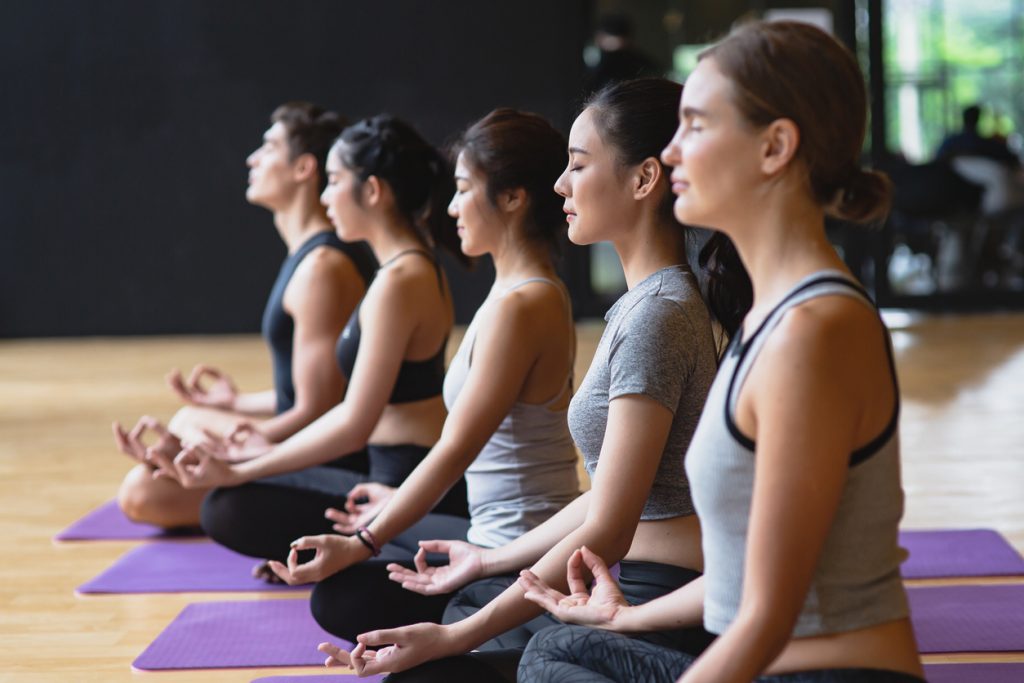
 Sh!t happens: traffic, family issues, deadlines at work, a missed morning alarm clock… While the reasons may vary, tardiness is an occurrence that you can prepare for. Studio protocol varies. Some studios lock the door 15 minutes after class has begun. Some, like group exercise classes at a health club, have an open door policy. Once a late student has entered the asana room, it is the responsibility of the teacher to include them into the practice as smoothly as possible.
Sh!t happens: traffic, family issues, deadlines at work, a missed morning alarm clock… While the reasons may vary, tardiness is an occurrence that you can prepare for. Studio protocol varies. Some studios lock the door 15 minutes after class has begun. Some, like group exercise classes at a health club, have an open door policy. Once a late student has entered the asana room, it is the responsibility of the teacher to include them into the practice as smoothly as possible. Some attention seeking behaviors present themselves easily. There is the student who talks during class, either to you, or to other students. To respond to this student encourages on-going dialogue. To allow for conversation among your students during class is a distraction to others. In response, you can offer the direction of “
Some attention seeking behaviors present themselves easily. There is the student who talks during class, either to you, or to other students. To respond to this student encourages on-going dialogue. To allow for conversation among your students during class is a distraction to others. In response, you can offer the direction of “


 Apana vayu is the subtle downward movement of energy within the body, and the key to maintaining a pregnancy to full term. Certain therapies, exercises, and herbs may disturb apana vayu. Therefore, the intent of this article is Ayurveda practices insight, rather than a treatment protocol. Due to the complexities of pregnancy, it is wise to leave treatments in the hands of experienced Ayurvedic practitioners.
Apana vayu is the subtle downward movement of energy within the body, and the key to maintaining a pregnancy to full term. Certain therapies, exercises, and herbs may disturb apana vayu. Therefore, the intent of this article is Ayurveda practices insight, rather than a treatment protocol. Due to the complexities of pregnancy, it is wise to leave treatments in the hands of experienced Ayurvedic practitioners. In her Ayurvedic essays, Terra Richardson of Cambridge University explains that a baby is physically conscious of his or her gestational development through the mother’s sense organs. Ancient Ayurveda acknowledges the development of the fetus’s sense organs through ceremonial rites preformed during different stages of pregnancy. According to Richardson, a modern-day pregnant woman can feed her baby’s senses by increasing the quality of her sensory input. She should “see beautiful and loving things, listen to loving and melodious sounds, touch pleasing things, and be touched in loving ways, taste wholesome tastes, and smell fragrant odors.” In other words, by surrounding herself in a beautiful, supportive, and loving environment, a mother’s womb becomes an equally safe, nourishing, and peaceful space for her baby’s consciousness to develop in.
In her Ayurvedic essays, Terra Richardson of Cambridge University explains that a baby is physically conscious of his or her gestational development through the mother’s sense organs. Ancient Ayurveda acknowledges the development of the fetus’s sense organs through ceremonial rites preformed during different stages of pregnancy. According to Richardson, a modern-day pregnant woman can feed her baby’s senses by increasing the quality of her sensory input. She should “see beautiful and loving things, listen to loving and melodious sounds, touch pleasing things, and be touched in loving ways, taste wholesome tastes, and smell fragrant odors.” In other words, by surrounding herself in a beautiful, supportive, and loving environment, a mother’s womb becomes an equally safe, nourishing, and peaceful space for her baby’s consciousness to develop in.

